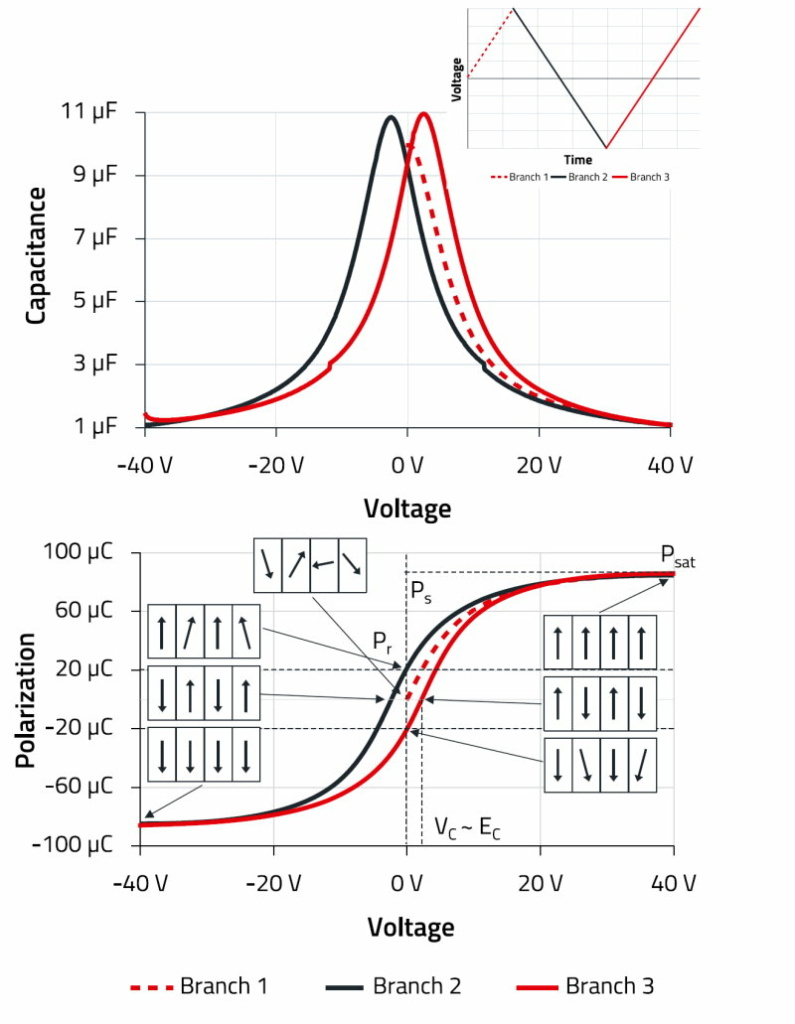
An insight into the voltage dependence of ferroelectric ceramic capacitors
An important dielectric property that ceramics can exhibit is ferroelectricity. In a ferroelectric material, all direct and indirect neighboring cells form dipoles pointing in the same direction, without the application of an electric field. This is a result of energy reduction due to dipole-dipole interactions. The ferroelectric strives to achieve a domain configuration that minimizes total energy while satisfying both electrostatic and mechanical constraints.
In an idealized system, all dipoles within a crystalline material would point in the same direction. In practice, however, the materials always have small defects, limiting the common orientation of dipoles to regions called domains. The size of the domains, the crystal configurations at the boundaries and the dipole orientation within all affect the polarizability and thus the permittivity of the material. This is why combinations of different raw materials exhibit different ferroelectric behavior.
Above the Curie temperature, which is specific to each ferroelectric material, the common alignment is destroyed; the dipoles are randomly oriented and no longer exhibit domain structure. Under these conditions, the material exhibits paraelectric properties, ie it can become polarized under an applied electric field. Ferroelectric materials are always exhibiting such behavior to some degree. Paraelectricity can also be caused by chemical additives that introduce defects into the crystal structure and thus prevent the formation of domains.

Ferroelectricity only occurs in crystals that have an elementary cell without a center of symmetry, ie a non-centrosymmetric shape. One such compound with a non-centrosymmetric structure is barium titanate. As the positively charged titanium ion is shifted slightly off-center, the unit cell is slightly more positively charged on one side and slightly more negatively charged on the other side (Figure 1). Since the permanent electric dipole interacts with applied fields, the polarizability and thus the permittivity of such materials is voltage dependent.
Compared to other materials, ferroelectrics such as barium titanate exhibit high polarizability and thus high relative permittivity. Multilayer ceramic capacitors (MLCCs) based on barium titanate have the advantage of combining low losses with high capacitance and small size. This makes them one of the most important passive components for switching converter and filter circuits. A disadvantage is their voltage dependence, which leads to a detrimental decrease in capacitance as the DC voltage increases.
Measurements
To understand how this works, let’s look at the capacitance-voltage and polarization-voltage diagrams of a specific MLCC (Figure 2). A sinusoidal sampling signal of frequency f is applied to measure the capacitance. The AC signal has a fixed amplitude throughout and causes the voltage dV to change periodically. A DC voltage is superimposed on the sinusoidal signal, which allows the domain polarization to be realigned.

The capacitor with randomly aligned domain polarization is exposed to the test signal. As the DC voltage increases in branch 1, the dipoles align, increasing polarization. When the dipoles align and the dipole motion becomes more restricted, the resulting charge change dq is smaller. Consequently, the capacitance C = dq/dV decreases as the DC voltage increases.
When the applied external field E, which is proportional to the applied voltage, has aligned the majority of the domains, the dipoles remain in that position even without the external field. The collective alignment creates a stabilizing internal coercive field, Ec. As the applied electric field is further increased, the overall polarization increases due to other polarization effects such as electronic, ionic and dipolar.
The polarization at maximum voltage is called the saturation polarization, Psat. In principle, the spontaneous polarization Ps is equal to the saturation polarization of the electric displacement extrapolated to the zero field.
In branch 2, the voltage, and thus the external field, decreases. As a result, the dipoles relax slightly but remain in their general polarization direction due to the internal coercive field Ec. The polarization state at zero volts is called remanent polarization Pr.
To reorient all domains in the opposite direction, Ec must be exceeded by a reversed external electric field. At the point of Ec, the stress on the dipoles is lowest, so the material’s permittivity (susceptibility) is greatest and the capacitance is at a local maximum. As the polarization increases in the opposite direction, the capacitance decreases to the same value as for positive stresses.
When the negative voltage decreases in branch 3, the dipoles relax. As the voltage changes from negative to positive, the dipoles reorient as soon as the externally applied field exceeds the coercive field. As the bias voltage passes through zero, the capacitance peaks. The process is similar to that described earlier. Branch 3 is similar to branch 2, except that it’s shifted along the x-axis toward positive voltages. Another voltage sweep would again lead to branch 2.
This hysteresis actually requires distinguishing between polarizations on voltage sweeps from positive to negative and vice versa. Basically, though, any increase in DC voltage will cause the dipoles to align and the capacitance to decrease. As a result, ferroelectric MLCCs exhibit voltage and frequency-dependent behavior.
Würth Elektronik has further developed a model for the description of this behavior and made it publicly and freely available in Spice. Developers can load files for MLCCs into the software to simulate the influence of the capacitors’ voltage and frequency behavior on their circuits. The underlying mathematical model is particularly suitable for implementation in simulation software and for fitting to a large portfolio. More information can be found in Würth’s application note on the topic.






